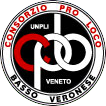GEOGRAPHY
The town, with its surface of 16,84 km², is located at an average altitude of 23m above sea level. It is 24 km southeast of Verona and its territory is completely flat. The river Piganzio di Valese and the river Bussè flow through its land. Many of the town’s areas coincide with the former areas of the older farmhouses: Casalandri, Casalati, Casalino, Casari, Casotti, Mandella, Merle, Ormeolo, Rabbia, Olmetto. It borders with the comuni of Bovolone, Roverchiara, San Pietro di Morubio, and Oppeano.
ETYMOLOGY
The original name was “Insula Porcaritia”; the word ‘insula’ –meaning island– since the settlement was located in an open space surrounded by woods and swamps, and the word ‘porcaritia’ meaning pigsty, because of the pig farms in and around the town. Throughout the centuries “Porcaritia” became “Porcarizza”, and then eventually “Rizza”. Another theory claims that “Porca” meant canal and “Ritia” came from “Richentia”. Richenza was the name of emperor Lotario’s wife, who contributed to the expenses of the digging of the canal, out of gratitude towards the people who once warmly welcomed her arrival. In 1872 the inhabitants managed to change the town’s name in Isola Rizza.
HISTORY
The first inhabitants of this area date back to the 2000s b.C. During the Iron Age, however, between 600 and 500 b.C., some paleovenetian population came from the east. Evidence of their presence was discovered around Pieve, with the remains of the ruins of some important settlements and a biconical urn. Another important finding around Casalandri, reveals the arrival of Celtic populations that in 225 b.C. integrated with paleovenetians and later on with the Romans.
The so-called “rotta della Cucca”, a disastrous flood that took place in 589, caused a change in the Adige’s course, creating wide swampy areas on the land. This event and the barbaric invasions caused a progressive deterioration of institutions and trade activities. Remnant of the Longobardic domination is a small treasure, constituted gold and silver objects discovered in a field and now entrusted to the Civic Museum of Verona. During the domination of the Scaligeri the town was under the lead of a bailiff elected by the inhabitants. In 1387 it became a parsonage subjected to Galeazzo Visconti, until his death, when Caterina returned it to the Comune of Verona. In 1404 the town’s area fell under the domination of the Carraresi and the following year under the control of San Marco, gaining a consistent autonomy and a valuable socio-economical advantage. The intensification of the land reclamation works allowed a progressive increase of the fertile lands, swiftly occupied by rice farms and vineyards. In this period several Villas and large country houses were built. Between the 1500s and the end of the 1700s the town suffered recurring pestilences brought by the several foreign armies constantly moving on its lands. With the arrival of Napoleonic Army, the village joined the jurisdiction of Legnago in 1805. The French were then pushed out by the Austrians in 1809 and their arrival brought a time of peace and economical regrowth. In November 1866, Isola Rizza entered the Kingdom of Italy. In the early 1900s, due to the hardships of a stagnant economy, a substantial emigration flow was directed towards America.
ART
Worth of note is the neat fifteenth-century church located in the town centre and dedicated to Santa Maria Janua Coeli, adorned with ancient frescos, such as a remarkable “Madonna con schiere di devoti” by Giovanni Badile. There is Palazzo Dogana, probably built in the late Middle Ages, on the ancient Richenza canal. The first villa of the Maffei, in Isola Rizza, was built in the early 1400s, and was then acquired by the De Medici and later by the Ferraris. Villa Pollettini, the current town hall, was also built in this century. It features a northern side in Neo-Gothic fashion, whilst the southern one preserves its grim original look. It is home to paintings of 1700s-1800s such as the famous “La finta malata”, work of the Venetian painter Giacomo Favretto, in the middle 1800s. In 1535, on the remains of the old 8th- century parish, the new church was built, later restored according to the standards of neoclassical architecture in 1789 and adorned with a pronaos and columns. It hosts a painting of Paolo Ottino (1570-1663) and an altarpiece of 1749. Both the elegant Villa Sagramoso Buri, now property of the Ferraris, and the sluices on river Bussè, date back to 1850 and are located in Gangaion.
Villa Bonanome Bellinato was built in 1589 with its large and well-preserved icehouse. Another remarkable example of the same age is Villa Martelli, with its central dovecote tower, radically refurbished a couple of centuries later. There is the 17th-century Villa Maffei, with a characteristic tower-house around Capra, and 18th-century Villa Ferrari, formerly known as Villa Zanetti with its mill and villa Mandella. Noteworthy are the Corte dominicale Miniscalchi al Casalino, the Pila Polandro (a 12th-century mill), Pila Gangaion and Pila Maza. Then there is the Croce del Gallo, a particular and well-preserved cross, typically found in the French military graveyards of the Napoleonic era.
ECONOMY
The economy traditionally revolves around agriculture, and only recently it changed with the establishment of medium and small industries. The farmers specialised in bird, pig and cattle raising, furthermore there is an important cheese factory where products such as Provolone and Grana Padano are made.
